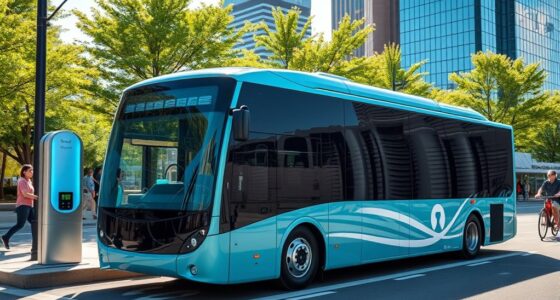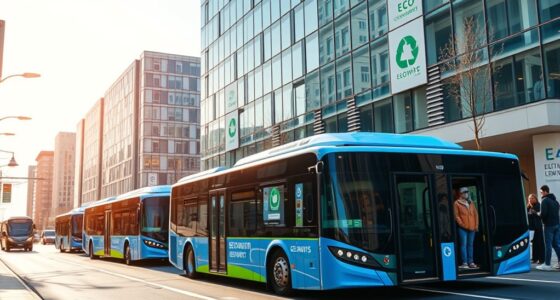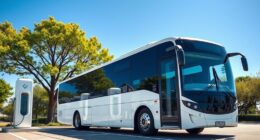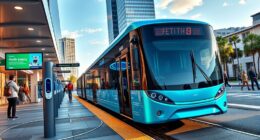To align electric bus charging with solar and wind power, you can use smart energy management systems that synchronize charging schedules with renewable production peaks. Incorporating battery storage buffers permits you to store excess energy for later use, reducing reliance on the grid. Integrating these systems with smart grids guarantees surplus energy is reused or fed back, boosting efficiency and stability. Exploring these methods further can reveal how to maximize sustainable benefits for your transportation needs.
Key Takeaways
- Integrate solar and wind energy sources with bus charging stations for renewable-powered electric bus fleets.
- Use battery storage to buffer excess renewable energy, enabling charging during low generation periods.
- Implement grid integration and V2G technology to balance renewable energy supply and demand effectively.
- Schedule bus charging to coincide with peak renewable energy production, maximizing use of clean energy.
- Employ smart energy management systems to optimize renewable energy utilization and reduce reliance on fossil fuels.

Have you ever wondered how electric buses can help reduce our reliance on fossil fuels? One of the key ways they do this is through the strategic use of battery storage and grid integration. When electric buses are charged using renewable energy sources like solar or wind, the entire transportation system becomes more sustainable. But to maximize these benefits, effective management of energy flows and storage is essential. That’s where battery storage comes into play, acting as a buffer that stores excess renewable energy generated during peak times for use when demand is higher or renewable output dips. This ensures that the energy powering your bus isn’t just clean but also consistent, overcoming the intermittency challenges associated with solar and wind power. Proper energy management is crucial for optimizing the use of renewable resources in transportation.
Grid integration takes this process a step further by connecting the local energy grid with renewable sources and electric vehicle charging stations. When buses are charged during periods of high renewable production, the grid can absorb the surplus, reducing reliance on fossil-fuel-based power plants. Conversely, during times of low renewable output, stored energy from batteries can be fed back into the grid to maintain stability. This bidirectional flow of electricity, often called vehicle-to-grid (V2G) technology, makes the entire system more resilient and efficient. It allows cities to better balance energy supply and demand, cutting down on greenhouse gas emissions and helping meet climate goals.
Imagine a city where electric buses are not only powered by renewable energy but also actively support grid stability. During the day, solar panels generate plenty of electricity, some of which is used to charge buses directly. Excess energy charges the batteries, which are then available for later use. If wind turbines are producing high amounts of power at night, that energy can be stored or fed into the grid, ensuring that no clean energy goes to waste. When buses need charging, they draw from this stored renewable energy, making their operation more eco-friendly and cost-effective.
This synergy between battery storage and grid integration creates a smart, flexible energy ecosystem. It reduces the need for fossil fuels and helps stabilize the power system, especially as renewable generation fluctuates. By aligning bus charging schedules with renewable energy production, you contribute to a cleaner environment and a more sustainable future. The shift to electric buses powered by renewables isn’t just about cleaner transportation; it’s about building an intelligent energy infrastructure that maximizes the potential of renewable resources, all while reducing our carbon footprint.
Frequently Asked Questions
How Do Electric Buses Impact Urban Air Quality Beyond Emissions?
You notice electric buses improve urban air quality by reducing harmful pollutants, but they also impact urban noise levels positively, making streets quieter. This quieter environment enhances pedestrian safety, allowing better awareness of surroundings and reducing accidents. Electric buses produce less engine noise, creating a more peaceful cityscape. As a result, cleaner air, reduced noise pollution, and safer pedestrian spaces all contribute to a healthier, more pleasant urban environment.
What Are the Main Challenges in Integrating Renewable Energy With Bus Charging?
Imagine a city implementing solar-powered bus charging stations. You face challenges like ensuring grid stability, as the surge during peak sunlight can strain infrastructure. Storage solutions, such as batteries, become vital to balance supply and demand. You also need to coordinate energy generation with bus schedules, making real-time management indispensable. These hurdles require careful planning and investment to effectively integrate renewable energy into bus charging systems.
How Cost-Effective Are Solar and Wind-Powered Bus Charging Stations?
Solar and wind-powered bus charging stations can be cost-effective over time, especially with favorable cost analysis and incentives. While upfront infrastructure investment might seem high, renewable energy reduces ongoing energy costs markedly. You save on fuel and electricity, and tax credits or subsidies can offset initial expenses. Over the long term, these savings make renewable-powered stations a smart, economical choice for sustainable transportation.
What Policies Support Renewable Energy Adoption for Electric Bus Fleets?
You can benefit from renewable incentives and strong policy frameworks that support renewable energy adoption for your electric bus fleet. These policies often include tax credits, grants, and rebates that reduce costs. Governments may also implement regulations encouraging cleaner transportation. By leveraging these incentives and policies, you’ll find it easier and more affordable to shift to renewable-powered charging stations, making your fleet more sustainable and aligned with environmental goals.
How Do Seasonal Weather Changes Affect Renewable Energy Availability for Bus Charging?
Seasonal weather changes cause fluctuations in renewable energy availability for your bus charging. During winter, shorter days and snow reduce solar power, while wind energy might increase or decrease depending on weather patterns. To guarantee weather resilience, you should diversify your energy sources and incorporate energy storage systems. This way, your fleet stays charged year-round despite seasonal energy fluctuations, maintaining reliable service regardless of changing weather conditions.
Conclusion
By aligning electric bus charging with solar and wind power, you harness nature’s energy instead of draining the grid. Imagine buses gliding silently through city streets, fueled not just by batteries but by the sun and wind. This isn’t just eco-friendly—it’s a bold step toward a cleaner future. As you embrace renewable energy, you turn the daily commute into a powerful act of sustainability, proving that technology and nature can work together for a greener tomorrow.









